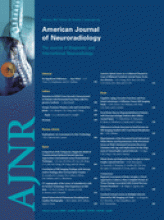Curtis A. Dickman, Michael G. Fehlings, Ziya L. Gokaslan, eds. New York: Thieme: 2006. 712 pages, 784 illustrations, $249.95.
By combining the pathology, clinical manifestations, imaging findings, interventional treatment, management, chemotherapy/radiation therapy, and surgical management of spinal cord and spinal column tumors, Drs. Dickman, Fehlings, and Gokaslan have put together a book that should be of interest to neuroradiologists and spine surgeons alike. In 44 chapters (694 pages), 80 authors have contributed to this well-illustrated and well-designed publication. For neuroradiologists, the value will not be in the MR/CT imaging per se because that material (chapter 5) is brief and standard fare. The authors of this 25-page chapter show few examples of bony lesions of the spinal column (osteoid osteoma, metastasis, hemangioma, myelodysplasia, and Langerhans cell histiocytosis), only sagittal images of spinal cord tumors, and several canal masses. Far better descriptions of spine tumors can be found in more detail in other text books. Also, there is no discussion or examples that highlight the frontiers of spine imaging, such as spinal MR angiography, CSF flow studies, or diffusion-weighted imaging of the spine. The imaging shown in other chapters of this book often is accompanied by correlative intraoperative photographs and/or histopathologic material. In fairness however, this radiology chapter was probably intended to be just a very short survey, which it is.
What specific material would be of value and unfamiliar to the neuroradiologist? The chapter on the “Pathology of Tumors of the Spine” by Dr. Coons from the Barrow Neurologic Institute is a key component of the book. In its 70 pages, the material covers nervous system tumors (central, peripheral, and meningeal), vertebral tumors, and soft-tissue tumors. There are many features of special interest to the neuroradiologist, including immunohistochemistry stains and the significance of their reactivity; the WHO grading for tumors; the varieties of meningiomas; a clear explanation and demonstration of the differentiation of Schwannomas from neurofibromas, neuroblastic tumors, and various germ cell tumors; and the pathology of vertebral column tumors. Of particular interest to this reviewer is a frank discussion of the issues surrounding the often contentious debate (and aired a number of years ago in the AJNR) concerning the diagnosis of gangliogliomas of the spinal cord. Widely discrepant numbers in the frequency of gangliogliomas versus pilocytic astrocytomas exist, and after reading this section, one begins to have an inkling of why this debate occurs and why some believe ganglion cell tumors are more common than generally acknowledged, whereas others question the validity of this diagnosis. That particular issue is highlighted in this review because it serves as an example of the straightforward manner in which this chapter is written. One gains insights as to why the statistics concerning the incidence of different tumor types vary so greatly from study to study and why the terminology for tumors is variable or seems to be a moving target. Readers not familiar with the details of histopathology of these tumors may believe that the standard specimens are underlabeled and not as fully described in the legends as they should have been; that would be a valid criticism for an otherwise excellent chapter. The 149 color plates of the pathology do, however, give one the opportunity of viewing a wide variety of spine tumors. The following chapter on “Cellular and Molecular Biology of the Central Nervous System and Peripheral Nervous System Neoplasms” complements the pathology chapter by reviewing the genetics, growth factors, and cell cycles involved in these tumors.
Therapy for spinal tumors is reviewed in short chapters on systemic and intrathecal chemotherapy, embolization techniques, and radiation therapy (external radiation, brachytherapy, stereotactic radiation, and Cyberknife). These sections would hold only minimal interest for the neuroradiologist—the chapter on the embolization is too short to be of great value to anyone actually doing endovascular surgery of the spine.
There is considerable redundancy in this book because different authors go about illustrating and discussing many of the same issues and cases. Cross referencing would have been of value. For example, when osteoid osteomas in chapter 2 were described, the appropriate image in chapter 5 could have been cited. Perhaps that type of problem is inevitable in a multiauthored text, but tighter editing with an effort to combine material would have made a shorter and equally valuable publication.
On the other hand, there are topics in the latter one third of the book about which the radiologist rarely reads but encounters indirectly through imaging. These include treatment decisions, techniques of spine reconstruction/fixation, and surgical approaches to all of these tumors. Operative approaches to the craniovertebral junction, the cervical spine, the cervicothoracic junction, the transthoracic/transabdominal approach to the spine, thoracoscopic surgery, along with other anterior and lateral approaches to the spine are described. These chapters contain vivid drawings, intraoperative photographs, and postoperative imaging, so the radiologist is able to gain a full perspective of the challenges and surgical issues involved. Many of the instrumented constructs radiologists encounter on a daily basis are dealt with in an interesting and well-illustrated manner. These are, incidentally, topics infrequently covered in the radiology literature, so the information in this book becomes even more valuable. A short chapter on percutaneous vertebroplasty and kyphoplasty summarizes the current status, techniques, and complications of these procedures for benign and malignant tumors.
Overall the imaging is properly described throughout the book; relatively few and minor problems crop up, such as inaccurately described images or showing an image and describing the findings but never stating the diagnosis or the surgical outcome. As indicated previously, however, the value of this publication lies in areas outside imaging itself. In summary, this book would be a valuable addition to the library of a department in which there are a large number of referrals from spine surgeons because it allows the radiologist to appreciate the many problems and issues that confront our surgical colleagues.

- Copyright © American Society of Neuroradiology












